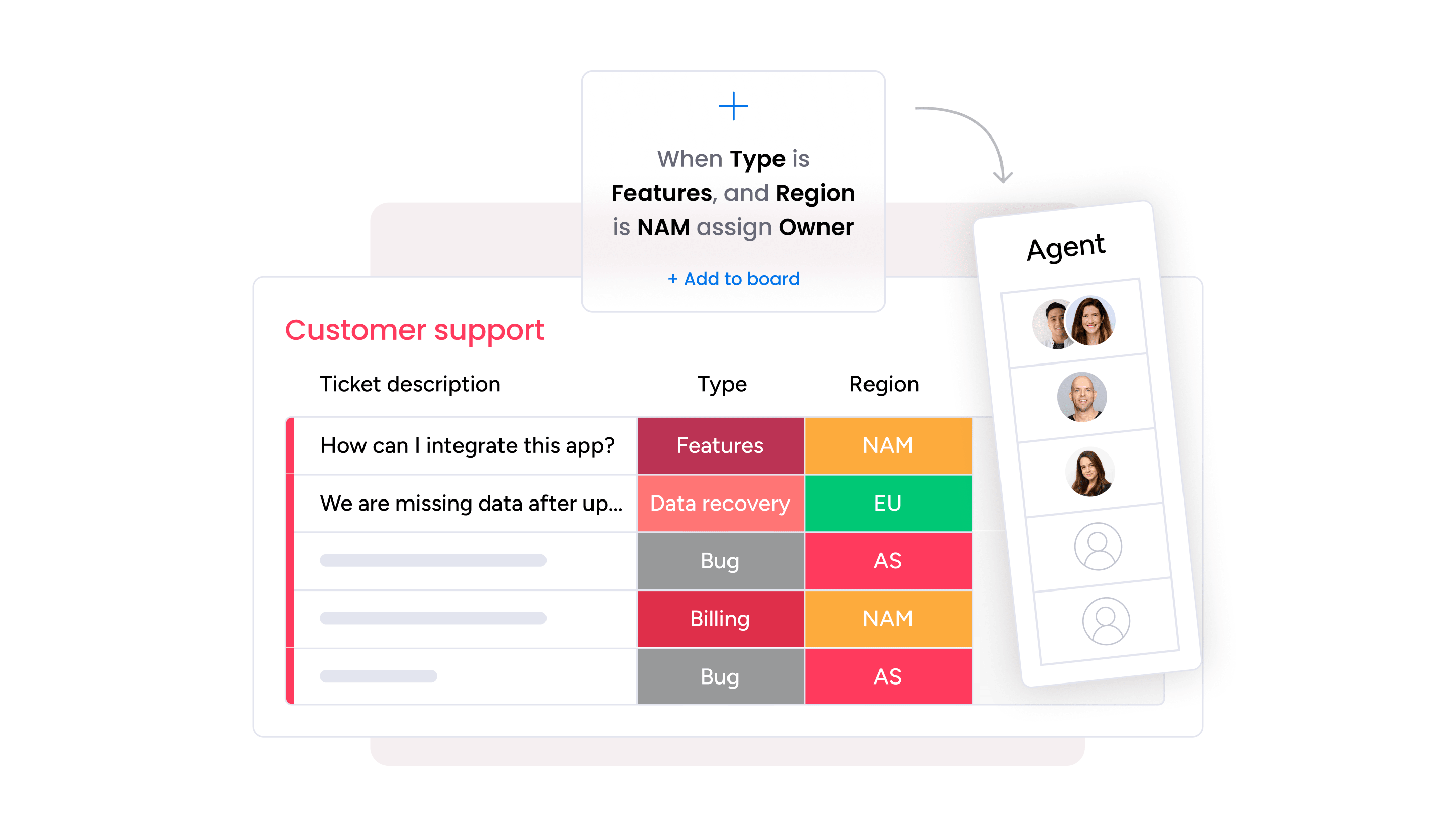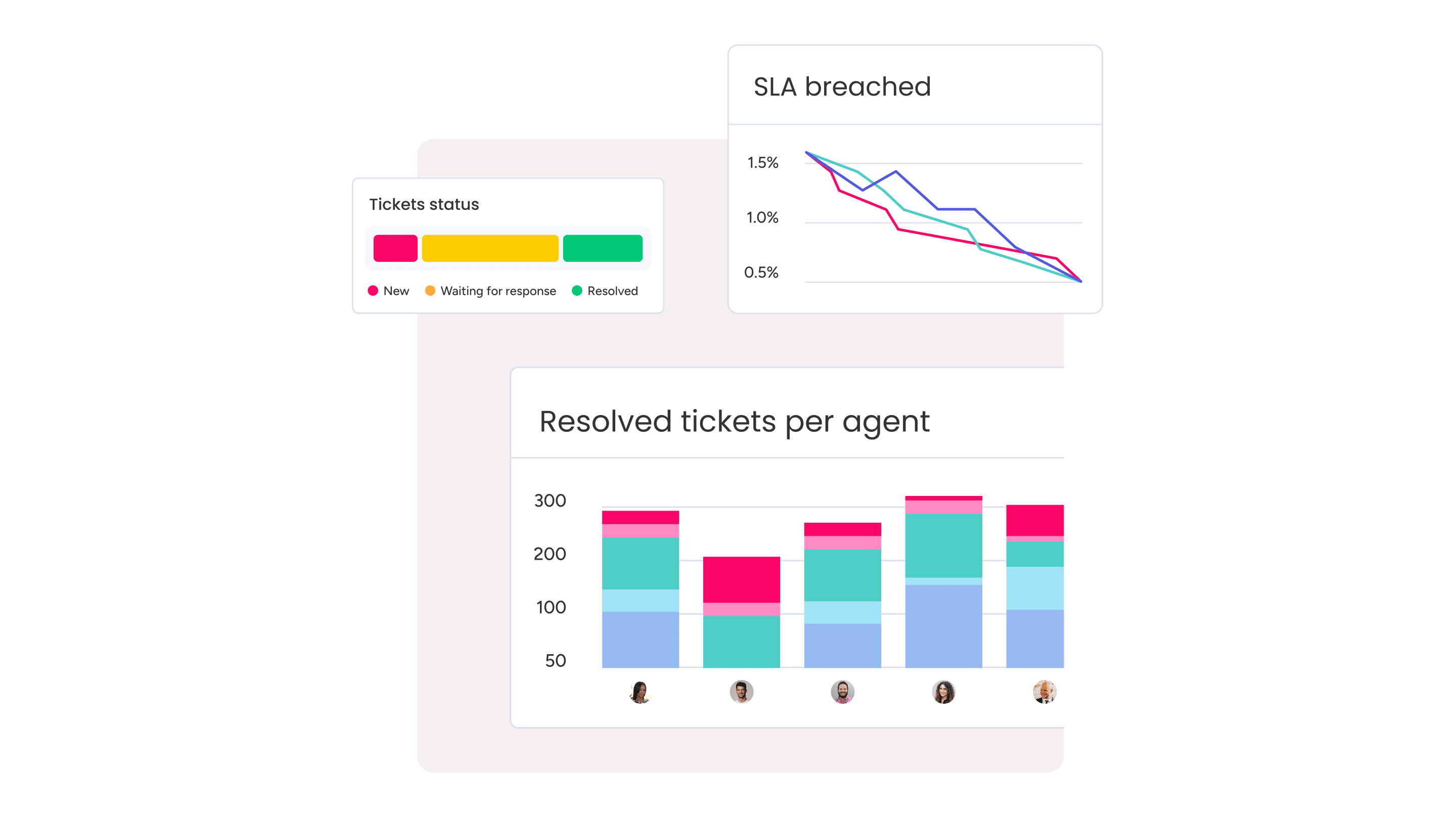Facilities service management can sometimes feel like a juggling act. Facilities managers are running countless procedures simultaneously, like tracking incoming service request tickets, maintaining building assets, and managing teams of contractors, cleaners, caterers, and countless others.
Managing all these tasks manually can be messy, leading to forgotten service request tickets, equipment that’s left broken, and can even lead to emergencies. Companies need facilities management software to keep track of everything, from small tasks like dispatching custodial service staff to tend to a clogged toilet to controlling security and cleanup for a large event.
In this blog post, we’ll explore the specific requirements of facilities management and dive deeper into how AI-powered software like monday service can help streamline facilities services operations.
Try monday serviceWhat is facilities service management?
Facilities service management involves organizing and planning services for facilities, such as security, maintenance, resources, cleaning, or people management.
The goal of facilities management is to continuously maintain and improve the setting in which individuals are operating so that they can concentrate on their tasks.
Facilities can include a wide range of settings, such as:
- A workplace building or office
- College campus community or other educational setting
- Athletic facilities
- Healthcare facilities
- Public locations with businesses and customers like museums and malls
As a service, it’s important for those in charge of facilities to have a strong administrative overview of all the different activities that they need to manage. There’s a wide range of responsibilities that fall under the service management umbrella. For building managers to handle it all, they need to streamline their service management with the right tools and software.
Understanding the different types of facility management
Facilities managers handle all kinds of requests on a daily basis, and it’s important to have a good grasp of the different types of requests to understand what your company needs in facilities management software. Facilities management can be divided into four unique categories, each with its specific type of requests.
Hard services
Hard services encompass the tasks that are related to building maintenance, operation, and utility services, and can include managing different systems such as:
- Electrical service
- Plumbing
- Heating ventilation and air conditioning (HVAC)
- Building security and alarm systems
- Fire safety systems
Soft services
Soft services are the services that aren’t related to a facility’s structure, but rather the immediate comfort and experience of the people in it. This includes services like:
- Cleaning
- Catering
- Interior design
- Mail management
- Landscaping
- Waste management
Real estate services
Real estate services refer to the management of the infrastructure of a space, and includes:
- Space planning
- Property acquisition
- Leasing
- Construction projects
- Workplace design
- Furniture buying
Workplace services
Finally, workplace services are focused on creating an environment within a structure that facilitates workplace operations and business services, such as:
- Building an inclusive workspace
- Encouraging a collaborative environment
- Planning for how workspaces are used
- Spaces that improve employee well-being and satisfaction
- Event support services
Facility management roles and responsibilities
Considering all the different types of facilities services, there’s a lot for facilities teams to handle. Before looking for tools and software to make managing all this work easier, it’s important to first evaluate the roles your team is responsible for and then look for a platform that will fit your workflows. Below, we’ll look at some of the most common roles and responsibilities in facility management.
- Budgeting: Facilities managers need to plan and submit budgets to upper management for projected expenses related to all services, like ongoing maintenance, larger repairs, contractors for services, and more
- Daily operational tasks: On a daily basis, facilities teams need to manage tasks and services related to repairs and maintenance, vendor management, cleaning, and making sure the building is stocked and set up for the comfort of the occupants
- Managing contractors: Some maintenance and repairs require external contractors, and facilities teams need to be able to manage scheduling, payment, and communication to make sure everything goes smoothly
- Create emergency response plans: Facilities teams are responsible for creating, distributing, and executing emergency response plans such as fire safety or security events
- Custodial services: Facilities managers also overlook custodial teams and is responsible for handling cleaning schedules, sanitation, stocking cleaning products, and managing waste
- Event services and meeting management: When occupants have events or large meetings, facilities teams need to arrange for setup, security, custodial needs, and manpower to make sure it goes off without a hitch
These are just some of the responsibilities that fall on facilities teams. Handling all these different tasks manually can make it difficult to keep track of all the different services, which is why it’s critical for companies to use facilities service management software like monday service to organize it all.
Try monday serviceThe benefits of using facilities service management software
With so much going on in facilities management, tracking it all without the right software can be challenging. Facilities managers need the right tool to make sure nothing gets forgotten. If the fire systems aren’t properly maintained, for example, it can lead to situations that can put occupants in danger. Implementing facilities management software benefits companies in a number of ways:
- Improve maintenance project management and tracking across your organization so you’re always aware of what needs immediate attention
- Manage incoming service requests from different departments and organize them by priority
- Plan and communicate emergency plans across your organizations by keeping essential documentation all in one place
- Send updates on maintenance progress to departments or individuals who have submitted requests
- Collect data to prevent breakdowns based on historical data so that you can better plan for future maintenance needs
- Use AI to organize resources and schedules more effectively by forecasting resources and personnel needs based on predicted volume
Improve facility management with AI and automation
Not all facility service software is made equally. Because there are so many different tasks and details to keep track of, it’s best for facility teams to look for software with strong AI and automation features that will help them reduce manual, repetitive tasks. Here’s a look at how AI and automation can be helpful for facilities teams:
Predictive maintenance
AI-drive facility management software can use historical data to help teams schedule maintenance and predict equipment failure before it happens, avoiding unnecessary downtime and costly repairs.
IoT device integration
By integrating data from IoT devices like sensors, AI-driven software can help teams monitor energy consumption for systems like HVAC, lighting, and other utilities services to improve efficiency and reduce costs.
Automated workflow management
Use AI-led automations to create work orders, assign tasks to specific departments or individuals, and send follow-ups on requests so that they’re always handled promptly without any manual intervention.
Learn how to use monday.com automations to eliminate manual tasks and streamline your workflows — with a short lesson in monday academy. Take monday’s automations 101 course.
Smart insights and analytics
Gain powerful insights into equipment and space utilization by relying on AI to gather trends, patterns, and data that can help teams maximize resources, optimize the use of rooms in a building, improve budgeting and planning, and extend the life of your assets.
AI-powered content generation
Using generative AI, facilities teams can quickly send custom communications like emails and fill in parts of longer content like emergency plans and documents that need to be shared company-wide.
Stay informed on all facility services with monday service
The best software option for facility management teams is to go for a platform that’s flexible, easy to use, yet powerful enough to handle all the different tasks that need to be done on a daily basis. With software like monday service, you get an intuitive facilities ticketing system that’s packed full of service and AI features.
monday service is an all-in-one platform that leverages AI to help service teams organize, optimize, and automate every service request and incoming ticket. Built on the powerful monday.com Work OS, monday service is an essential platform for facility management teams that want to keep track of all their services while streamlining workflows.
Let’s look at some of the key monday service features that can make facilities service management easier.
Save time with service request ticketing automations

Use monday service’s AI features to automatically sort, prioritize, and assign incoming tickets so that you can save time on manual tasks, make sure each service request goes to the right department, and focus on completing requests.
Scale your facility workflows on demand
Build custom no-code automations and workflows that can easily be duplicated when you need to expand services to other areas or onboard new team members to handle different facility roles.
Monitor facility trends with advanced dashboards

Keep a close eye on facility service operations and performance to get a visual overview of trends like issues from tickets that come up frequently so you can identify areas that need more attention or immediate maintenance.
Create an AI-powered knowledge base
Use AI to suggest and generate content to fill your knowledge base with guides and articles that can help direct your facilities team, or create a database of maintenance manuals and emergency guides that can be shared across your organization.
Try monday serviceThe future of facilities service management
AI and automation will play an even greater role in offering more efficient services for facilities in the future. With more companies using smart devices to create entire smart buildings, it will be easier for facilities teams to use real-time monitoring and predictive analytics to improve building management. By using cutting-edge software like monday service, facilities teams can access the latest in AI features and technology and use it to improve how teams handle and manage facility requests and services.
FAQs
What are the 4 pillars of facilities management?
The four pillars of facilities management are people, processes, buildings, and technology. Facilities managers are responsible for a wide range of tasks, but they all relate to one of the four core pillars.
What is FMS in facility management?
A facility management system, or FMS, refers to the technologies, software, tools, and processes facility managers use to manage a physical environment.
What is the difference between FMS and BMS?
A building management system, or BMS, is a platform that manages, controls, and monitors various mechanical and electrical systems in a facility. While a BMS is focused solely on a building’s structure, a FMS also helps manage other aspects of the facility, like needs of occupants, design, and more.
